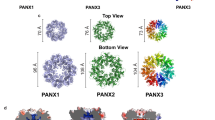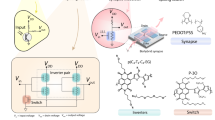Abstract
VISUAL pigments are components of the membranous disks of the rod and cone outer segments of vertebrates1. The traditional picture of visual pigment500 (rhodopsin) is a chromophore (retinal) bound to opsin through a Schiff base linkage2,3. A role has long been sought for the large quantities of phospholipids present in outer segment disks, however, and it has been proposed that, in native visual pigment, retinal is bound by a Schiff base linkage to phosphatidyl ethanolamine (PE) rather than to opsin4–6. When exposed to light, retinal is considered to migrate from PE to the ε-amino group of a lysine residue in opsin, but Heller7 has found that purified visual pigment contains little or no phospholipid (<2 per cent). The following experiments are intended to resolve this contradiction; we have used the recent observation that visual pigment in the outer segment disks is continually being renewed8,9, to show that purified visual pigment contains no phospholipid.
This is a preview of subscription content, access via your institution
Access options
Subscribe to this journal
Receive 51 print issues and online access
$199.00 per year
only $3.90 per issue
Buy this article
- Purchase on Springer Link
- Instant access to full article PDF
Prices may be subject to local taxes which are calculated during checkout
Similar content being viewed by others
References
Dewey, M. M., Davis, P. K., Blasie, J. K., and Barr, L., J. Mol. Biol., 39, 395 (1969).
Bownds, D., Nature, 216, 1178 (1967).
Akhtar, M., Blosse, P. T., and Dewhurst, P. B., Biochem. J., 110, 693 (1968).
Poincelot, R. P., Millar, P. G., Kimbel, R. L., and Abrahamson, E. W., Nature, 221, 256 (1969).
Daemen, F. J. M., and Bonting, S. W., Nature, 222, 879 (1969).
Fukami, I., and Fukami, Y., Nature, 223, 63 (1969).
Heller, J., Biochemistry, 7, 2906 (1968).
Hall, M. O., Bok, D., and Bacharach, A. D. E., Science, 161, 787 (1968).
Hall, M. O., Bok, D., and Bacharach, A. D. E., J. Mol. Biol. (in the press).
Rouser, G., Galli, C., Lieber, E., Blank, M. L., and Privett, O. S., J. Amer. Oil Chem. Soc., 41, 836 (1965).
Wagner, H., Horhammer, L., and Wolff, P., Biochem. Z., 334, 175 (1961).
Bartlett, G. R., J. Biol. Chem., 234, 466 (1959).
Heller, J., Biochemistry, 8, 675 (1969).
Heller, J., Biochemistry, 7, 2914 (1968).
Wald, G., and Brown, P. K., J. Gen. Physiol., 38, 189 (1953–54).
Hess, H. H., and Thalheimer, C., J. Neurochem., 12, 193 (1965).
Author information
Authors and Affiliations
Rights and permissions
About this article
Cite this article
HALL, M., BACHARACH, A. Linkage of Retinal to Opsin and Absence of Phospholipids in Purified Frog Visual Pigment500. Nature 225, 637–638 (1970). https://doi.org/10.1038/225637a0
Received:
Revised:
Issue Date:
DOI: https://doi.org/10.1038/225637a0
This article is cited by
-
Light-dependent phosphorylation of rhodopsin in living frogs
Nature (1974)
-
Linkage of Retinal to Opsin
Nature New Biology (1971)
-
Is Retinal-Phosphatidyl Ethanolamine the Chromophore of Rhodopsin?
Nature (1970)
Comments
By submitting a comment you agree to abide by our Terms and Community Guidelines. If you find something abusive or that does not comply with our terms or guidelines please flag it as inappropriate.



